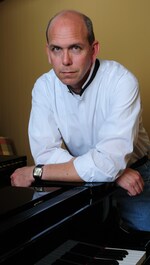To the various realizations of The Seven Last Words of Christ by Haydn, we can now add yet another arrangement. In the charming, sylvan setting of the Church of the Nativity in northwest Raleigh, four members of Aurora Musicalis presented the nine movements of this great and somber Good Friday work. Violinists Rebekah Binford and Ariadna Ilika, violist Christine Martin and cellist Elizabeth Beilman brought consummate skill and the requisite level of anguish to this string quartet version. Each of the seven “Word” movements was introduced by an applicable reading from the Gospels, along with the corresponding stanza from Mark Strand’s poem, “The Seven Last Words,” wherein the poet muses and enlarges upon that specific saying of Jesus. (Canadian-born Strand is a prolific writer and former U.S. Poet Laureate.) Serving as readers were ministers and leaders from the church staff. As the action progressed, each reader concluded by extinguishing one of the original seven lighted candles.
After the magisterial Introduction movement, the players launched Word I marked Largo. “Father, forgive them; for they know not what they do.” (…we may feel that he is pleading for us…) The tuneful and (relatively) upbeat Word II was marked Grave e cantabile. “Today shalt thou be with me in paradise.” (…there the wind will sing and be your voice…) The Grave marking was again called upon to characterize Word III as the low strings echoed the wail of the highs. “Woman, behold thy son…Behold thy mother!” (…a purpose revealed, a secret exchanged…a truth to which they…would be bound…)
Word IV, Largo: “My God, my God, why hast thou forsaken me?” (No one escapes. Not even the man who saved others…) Word V brought forth a violent Adagio along with repeated first violin solo to frenzied pizzicato accompaniment. “I thirst.” (To try to open one’s eyes…To feel the mouth burn…) Word VI, Lento, declared that “It is finished.” (…to be both large and small in the same instant, to be like us, but more so…) In Word VII, Largo again, the weeping violins concluded the seven sayings with “Father, into thy hands I commend my spirit.” (…a place of constant beginning…what no eye has seen, what no ear has heard…)
With the cataclysmic Conclusion, Haydn laid the sound-effects groundwork for later composers. “…and the earth did quake and the rocks rent; And the graves were opened…”
Here was a series of mini-quartets by Papa Haydn at his very finest. (It sometimes seemed as though he had taken lessons from the much younger Beethoven!) In case anyone had doubted, it showed that the liturgical and the artistic can coexist to their mutual enormous benefit. For such creative and devotional artistry, the faith community owes major thanks to Aurora Musicalis and Church of the Nativity’s surpassing series, “Spirituality in the Arts.”











